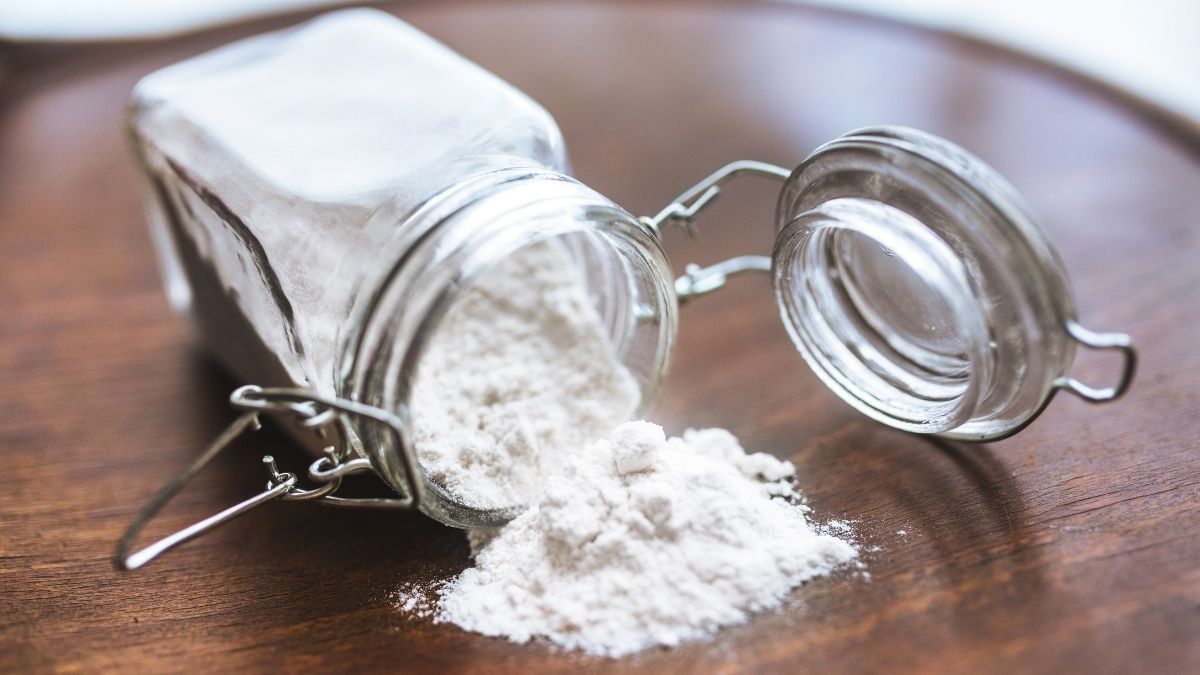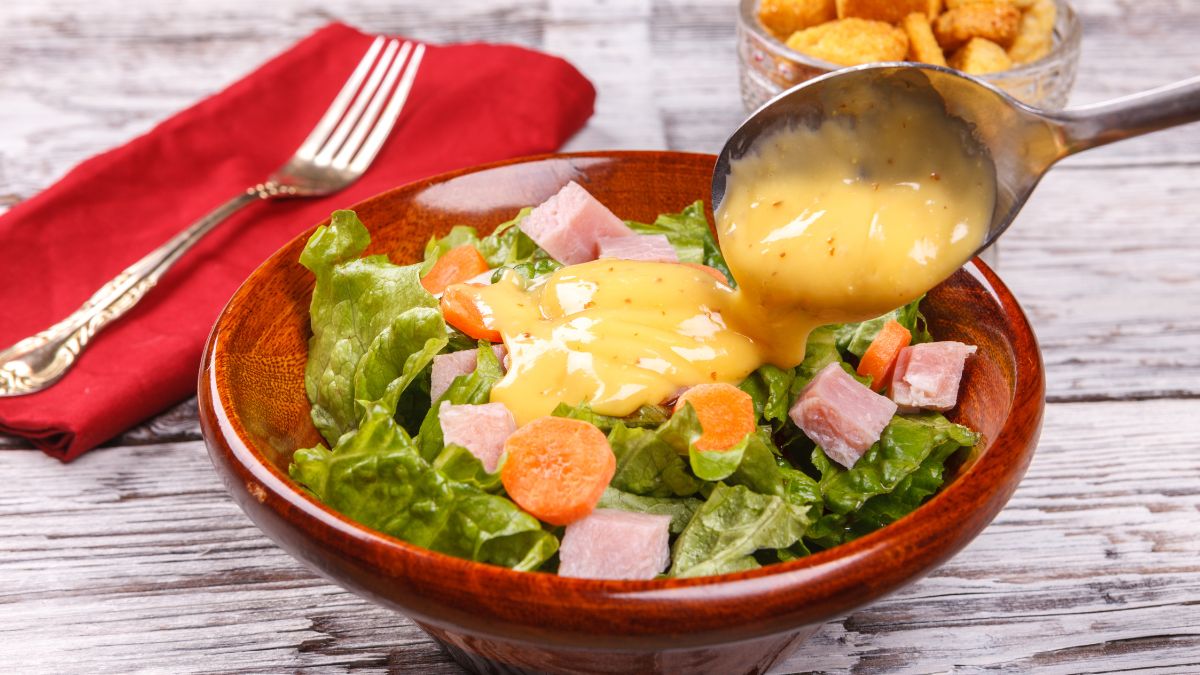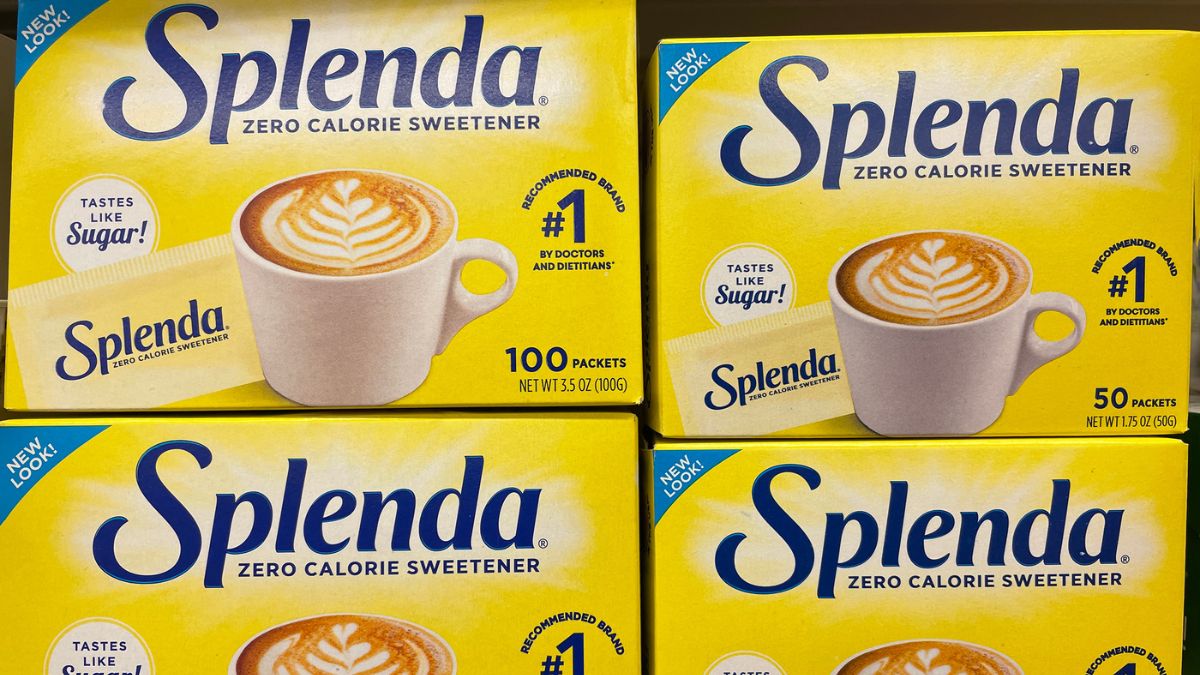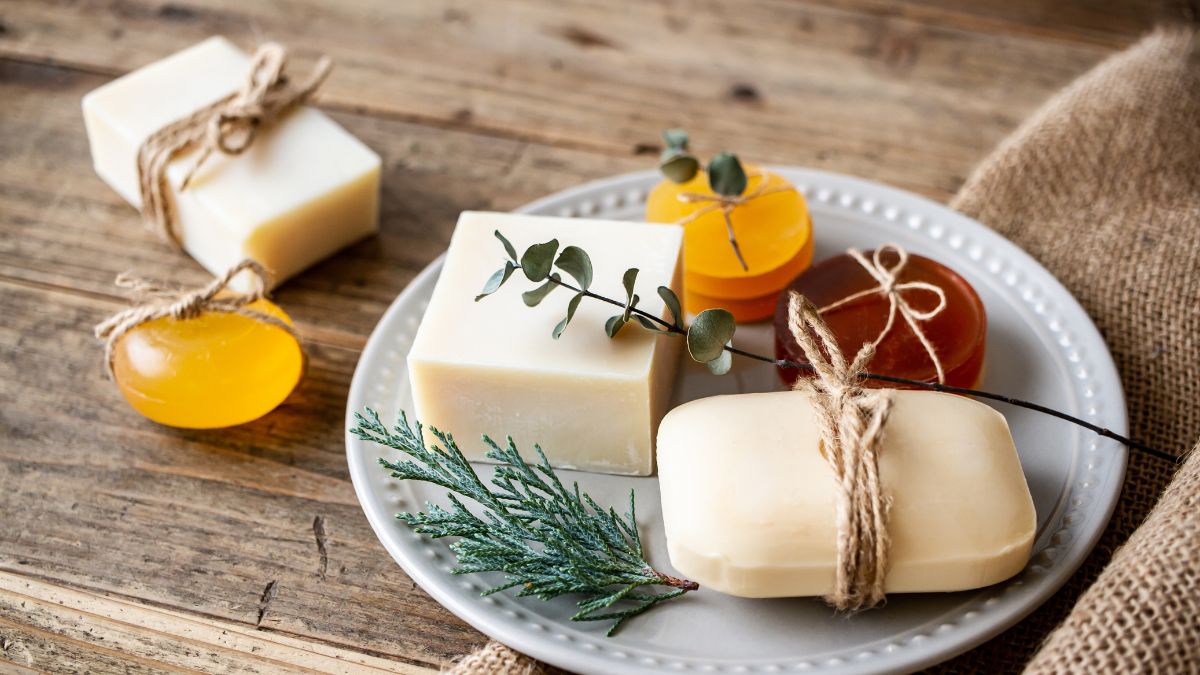Answer: Yes.

Baking soda, also known as sodium bicarbonate, is a substance obtained from inorganic minerals such as salt, limestone, and kelp, to name a few. As a common household ingredient used as leavening in baked goods and cleanser in some cases, it is an almost indispensable component in your cabinet arsenal.
What’s In Baking Powder
As stated prior, there are just three simple ingredients in baking powder: an acid, a base, and a filler, but there’s more to these ingredients that you should be aware of such as baking soda since although they sound the same, they do not always come as one, and either of them have separate uses for particular situations.
Also, note that baking powder comes in two varieties: single-acting and double-acting, and depending on which variety you use, the ingredients may vary slightly, but for the sake of clarity, let’s introduce first the original ingredients of classic baking powder. The rest comes later.
Baking Soda (Sodium Bicarbonate)
Baking soda is the basic (alkaline) component of baking powder a white, powdery substance resembling salt. It has a slightly salty taste and is commonly used as a raising agent in baking. It can also be used to clean fruits, vegetables, furniture, and even your teeth, but only in pinch amounts (don’t brush your teeth with a chockful of baking soda, just don’t, please).
Furthermore, baking soda is a naturally occurring mineral found in nahcolite which is a pure, crystalline form of sodium bicarbonate. These minerals are usually found in natron deposits of saline lake beds that have been dried up, or sometimes in mineral springs. It’s absolutely safe to consume since it’s a distant cousin of table salt.
Cream of Tartar
Cream of tartar is a byproduct of winemaking and is also a white powder that can be used both in baking and cleaning if mixed as an acidic solution. This baking ingredient is also known as potassium hydrogen bitartrate in the chemistry world. Despite its looks, this substance is actually the acidic component of baking powder and is the solid form of tartaric acid, hence its given name.
Potassium bitartrate is used as a stabilizing ingredient that mitigates the amount of caking and thickening in typical foods, prevents sugar syrups from crystalizing, and helps maintain the natural coloration of boiled vegetables. When combined with baking soda, a chemical reaction occurs that releases bubbles of carbon dioxide which then causes the batter to expand and “rise.” Cream of tartar can also be used as an effective substitute for baking soda or baking powder in case you ran out, and it’s given a 2:1 ratio with baking soda.
Cornstarch
Cornstarch, or cornflower, is an organic carbohydrate processed from the endosperm of corn. To start, cornstarch is 100% vegan as its main ingredient is derived from corn only. This powdery substance is used as a thickening agent both in cooking and baking.
Cornstarch is also 100% gluten-free as it’s completely made up of carbs and no protein at all. Hence, cornstarch is now commonly used as an alternative or replacement for wheat flour as the results prove to be more desirable. It has twice the thickening power of flour, it’s flavorless, and it creates a transparent, gelatinous mixture instead of opaque.
Nonetheless, both flour and cornstarch could be used interchangeably or together to create the desired texture of battered foods and baked goods. Also, if you have a particular recipe that calls for large quantities of flour, it’s best not to rely heavily on cornstarch for that, since it’s high in carbs and calories and very low on necessary vitamins and minerals, and too much consumption of it may lead to high blood sugar. Yet, if you want a gluten-free recipe, you can always pair cornstarch with a non-wheat flour alternative too, such as rice flour. You can check for non-wheat flour alternatives on WebMD, Guide to Non-Wheat Flours.
Baking Powder and Baking Soda Are 100% Vegan-Friendly
After diving deep into the details of the main ingredients of baking powder, we can pretty much conclude that baking powder is 100% vegan-friendly. Baking soda is also 100% vegan-friendly since it is derived from naturally-occurring mineral sources. Cream of tartar is a byproduct of winemaking which is the fermentation process of special fruits. Curious about winemaking? See more on Wine Folly.
If you are more interested in drinking wine rather than making it, take a look at this top-rated Winc wine club.
Cornstarch is completely extracted from the endosperm of the corn crop and is also gluten-free. When these three substances are put together, we get baking powder as the result which is used as leavening, stabilizer, and thickener for your baked goodies and battered foods.
Baking Powder, Baking Soda, and Gluten
So here comes the infamous question, Is baking powder gluten-free? Well, it only depends on which thickening agent the brand of baking powder uses. Since baking soda comes from inorganic minerals, it’s definitely gluten-free. While the cream of tartar comes as a byproduct of winemaking from fruits, it’s also gluten-free. Fret not either about cross-contamination since baking soda and cream of tartar are both processed very differently from other powdered substances, it is nearly impossible for any contact to be made with glutenous products.
When choosing baking powder in 2025, it’s important to pay attention to the thickening agent used, as this can vary widely between brands. Many brands rely on classic cornstarch, but others may use rice, tapioca, potato, arrowroot, or wheat starch. If you follow a gluten-free or vegan diet, be cautious of wheat starch because it contains gluten—a protein found in wheat, rye, and barley. According to the FDA, wheat starch is only considered gluten-free if it contains less than 20 parts per million (ppm) of gluten, but this specially processed wheat starch is rare and often costly. Most baking powders today opt for cornstarch, which suits many diets, including vegan. However, if you have a corn allergy or intolerance, alternatives like arrowroot or potato starch are excellent vegan-friendly options. For those wondering, baking soda is naturally vegan, making it a reliable choice if you’re looking to keep your recipes both vegan and gluten-free.
There also shouldn’t be any problem with cross-contaminants here either since brands typically produce only one variety of starch and so if you pick the gluten-free ones then you could rest assured that it’s safe and clean. Otherwise, the company would be sure to put up a disclaimer if cross-contamination may have been possible.
Here are the top brands of gluten-free baking powder to look for:
- Goldbaums – premium quality ingredients, potato starch, Kosher, no aluminum
- Dr. Oetker – high quality with an affordable price
- Argo – Kosher, no aluminum
- Rumford – no GMOs
- Rumford Reduced Sodium – no GMOs, contains 30% less sodium than the average
- Clabber Girl: Double Acting – Kosher, Halal, decently low price
- Ener-G Aluminum-Free – no aluminum, no sodium, no potassium, good for kidney dialysis patients and allergen-sensitive consumers
- Gefen – non-cornstarch, no aluminum, Kosher
- Davis – high quality, no bad aftertaste
- Hain – no sodium
How to Use Baking Soda and Baking Powder
Now that we’ve thoroughly explained how baking powder and baking soda are vegan-friendly, gluten-free products, there should be enough reason why you’d want to use them in your daily cooking and proper diet, but of course, we won’t leave it at just that. In case you haven’t been completely convinced yet, here are some tips for using baking powder and baking soda and why they are so important in creating delicious baked goodies among other things.
Baking Soda as a Leavening Agent
Baking soda is widely used as a leavening agent since its discovery it was originally for the sole purpose of finding a cheaper and cleaner alternative for baking leavened bread. As stated before, baking soda is an alkaline dry substance, which means that it’s a basic chemical with a pH of 8.3. So, to maximize the leavening power of baking soda, it has to be added to an acid, such as cream of tartar or white vinegar, to undergo a chemical reaction that triggers the expansion of carbon dioxide bubbles which then gives the “rise” to baked goods.
Baking soda is a very important ingredient in baking cakes, muffins, and cupcakes, without it, these treats would lay flat as you would in bed when your alarm’s already ringing. It is important to balance the amount of baking soda in a recipe with the acidic compound so that the reaction would produce perfect results, otherwise, too much baking soda would leave a bitter, soapy taste in your cake, or too little baking soda would not cause it to rise at all.
The Difference Between Baking Powder and Baking Soda
Now, it finally comes down to the relevant differences between baking powder and baking soda.
A good tip would be that baking soda is best used as a leavening agent when your recipe already contains an acidic compound; this could be lemon juice, vinegar, cream of tartar, or even brown sugar. Baking powder on the other hand is preferable when the recipe does not contain any of those aforementioned. This is really just for the sake of triggering a base-acid reaction to make the pastry rise. It’s also good to remember that baking powder adds thickening to the batter or mix as well since it also has a form of starch.
Baking Powder: Single-Acting
The single-acting baking powder, as its name suggests, reacts once and quickly right after being mixed in with your wet ingredients. So, if you have this variety then it’s best to immediately smack it into the oven and get cooking. If you dawdle with this type, your batter or cake mix would immediately smack back into a flat, dull pool.
However, this type of baking powder is not commonly sold anymore as they are more or less used in manufacturing instant cake mixes or packaged cookies and biscuits. This is also the variety that originally contained cream of tartar as potassium bitartrate is a quick-acting acid.
Baking Powder: Double Acting
The double-acting variety is what you will commonly see nowadays, and you probably already have one around your shelves. When it comes to home baking recipes, the baking powder would mostly refers to the double-acting type. This variety is also very easily obtained and comes in slightly different formulations. You can refer back to the list I put above.
Double-acting baking powder reacts twice, once when mixed with wet ingredients, and the second when introduced to heat. This is because the double-acting type contains a slightly different acidic compound that is activated by heat. A good example is sodium pyrophosphate which is a high-heat acid that reacts slowly with basic ingredients, making it a high-quality acidic compound in common double-acting baking powders, such as Goldbaums.
Another point you should be aware of with double-acting baking powders is the potential presence of sodium aluminum sulfates which adds a slight metallic taste to your goods. This could be due to either adding too much baking powder or using a gluten-free baking powder that contains much of it. So, to avoid this, you would want to check out products that are labeled “aluminum-free.”
Baking Powder Substitutes
First off, though some people would tell you that baking soda is an “okay” substitute for baking powder, this is not completely true. In order to substitute baking soda for baking powder, you would need thrice the amount for the recipe, and this causes potential drawbacks. Baking soda has a salty bitter taste that using too much of it would offset the taste of your recipe. The cake would end up like a dense lump of brown stuff due to the lack of acid-base reaction and also the heavily alkaline environment.
You can simply make your own baking powder if you have baking soda, cream of tartar, and a form of gluten-free starch. The teaspoon proportions would be 1:2:1 respectively.
White vinegar or common vinegar is also a good substitute for baking powder. It is an acidic substance that can be combined with baking soda in 2.5:1 gram proportions for every 5 g of baking powder needed. Watch out for the strong taste and aroma of vinegar though, to help with this, use organic white vinegar.
Self-rising flour is a final substitute if you have neither baking powder nor baking soda. The common type would only contain flour, salt, and baking powder. Otherwise, you can replace the water with club soda, a sodium carbonate beverage, and all-purpose flour to mimic the fluffy rise for your baked goods.
These are a few more good replacements and techniques for baking powder and baking soda too, but for the sake of relevance, let’s save that for another time.
Last Tips Before You Go
The best thing about this is that for all vegans out there, baking soda and baking powder stay true as your best buddies in baking your favorite, plant-based delights. They also happen to be gluten-free as a bonus in case you’re cutting down on that or simply sensitive due to celiac disease.
The simple ingredients in baking powder are all safe to eat, and since you only need a few pinches of these for your recipes, you can safely stir away from consuming too much. Just remember to pick the brand that is most suitable for your taste and health, or perhaps you might also want to DIY a personal baking powder recipe which is ultimately fine.
And a few practical tips to leave would be to always store baking soda and baking powder in a clean, dry place since severe humidity could tamper with their quality. Baking soda would last you a long time but loses its effectiveness and so make sure you don’t store it away for too long otherwise you’d be missing out on a lot of your baking and cleaning agendas. Baking powder has a decent amount of shelf life as well, just keep it far away from any moisture and put it in a tight container.
To test if baking soda is still good, just drop a teaspoon of it onto white vinegar or lemon juice and if it froths then it’s still useable. For baking powder, add hot water to it, and if the mixture bubbles, it’s still good.
So please remember to always enjoy your baking with these two very important components in your cabinet arsenal.




